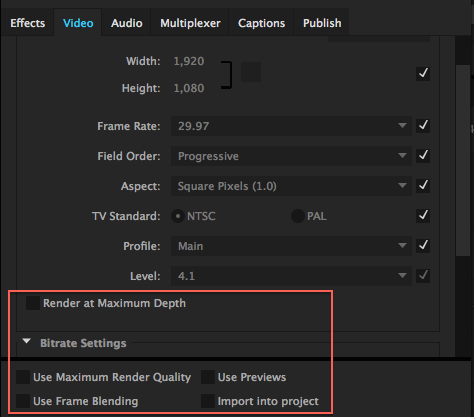

- #ADOBE ENCORE CS6 TIMELINE DEFAULTS UPPER FIELD HOW TO#
- #ADOBE ENCORE CS6 TIMELINE DEFAULTS UPPER FIELD MOVIE#
- #ADOBE ENCORE CS6 TIMELINE DEFAULTS UPPER FIELD CODE#
- #ADOBE ENCORE CS6 TIMELINE DEFAULTS UPPER FIELD PROFESSIONAL#
You can’t place ActionScript 3 statements directly on symbol instances.ĪctionScript 3.0 is stricter about a number of coding practices.

If you’ve worked with older versions of ActionScript, you should be aware of some key differences:ĪctionScript 3.0 can only be placed on keyframes in the Timeline or external (.as) files. Previous versions of ActionScript (1.0+, 2.0) are still in use among some Flash projects, so you still have options for creating or saving movies with older ActionScript version settings, if necessary. Since its introduction in Flash Player 9, ActionScript version 3.0 has brought many major changes and improvements to the way ActionScript performs and to the way it’s created within movies.
#ADOBE ENCORE CS6 TIMELINE DEFAULTS UPPER FIELD MOVIE#
action, you just need to preview the movie in Flash Player.ĪctionScript is understood and processed within Flash Player, so most scripted movies need to be tested by choosing Control⇒Test Movie. Don’t worry: To see ActionScript in, well. If you press the Enter or Return key to watch a movie clip play on the stage, you’ll probably be a little disappointed. To enable Script Assist mode, click the Script Assist icon in the upper-right corner of the Actions panel.

Script Assist mode helps prevent time-consuming errors so that you spend more time being creative and less time troubleshooting.
#ADOBE ENCORE CS6 TIMELINE DEFAULTS UPPER FIELD CODE#
This mode acts as a wizard within the Actions panel to let you use a series of menus, buttons, and text boxes to build scripts without having to get into the nuts and bolts of writing code by hand. To place an action on a frame, select the frame on the Timeline and launch the Actions panel.įor users new to ActionScript, an alternative to using the Code Snippets panel or tackling hands-on coding is Script Assist mode. To launch the Actions panel, choose Window⇒Actions or use the F9 (Windows) or Option+F9 (Mac) shortcut key combination. (We highly recommend the Script Assist mode for new users.) A handy Script Assist mode (see the next section) is available so that you can add and modify actions without having to type the code by hand. You can also add actions from the Actions panel using a categorized tray, drop-down list or type them directly into the script editor. The Actions panel, shown in Figure 7-2, acts as a wizard, reference book, and script editor all in one. If you are comfortable writing code by hand or have experience with other scripting languages (such as JavaScript), you can use the Actions panel to write your own code statements throughout your movie. Whether you want to navigate the Timeline, play sounds, or control video in your movie, a code snippet can help.įigure 7-1: The Code Snippets panel contains dozens of useful pieces of ActionScript you can use in your movies. The Code Snippets panel contains dozens of useful pieces of code that you can easily apply in a single click. If you’ve never written ActionScript, the learning curve can be a bit daunting, and sometimes you just need to get the job done. You can also make highly interactive movies by adding controls to your movie, allowing users to drive the action.Ī great tool for designers and code newbies is the Flash CS6 Code Snippets panel, shown in Figure 7-1. In its most basic form, ActionScript is used for Timeline control so that you can tell animations when and where to stop, loop, play, or jump to other points along a Timeline.
#ADOBE ENCORE CS6 TIMELINE DEFAULTS UPPER FIELD HOW TO#
Think of ActionScript as a set of instructions you can give your movie to tell it how to behave and add abilities. The ActionScript language comprises a vast series of commands that are placed on the timeline, within movie clips, or in external files using the Actions panel and the Code Snippets panel. This chapter introduces you to ActionScript and shows you how to use it to create interactive elements, such as clickable buttons, in your movies.ĪctionScript is a powerful scripting language that you can use to control playback, navigation, and imported media, such as images, video, and audio. This powerful built-in scripting language can help you do everything from controlling basic movie playback to creating complex games and even loading dynamic content and data. If you want to take your movies to the next level, then, ActionScript can help. Whether you’re creating a website, mobile application, or game, you can’t create a truly interactive experience without giving your users total control of the action.
#ADOBE ENCORE CS6 TIMELINE DEFAULTS UPPER FIELD PROFESSIONAL#
Adobe Creative Suite 6 Design and Web Premium All-in-One For Dummies (2012) Book VII Flash Professional CS6 Chapter 7: Controlling Your Movie with ActionScript


 0 kommentar(er)
0 kommentar(er)
